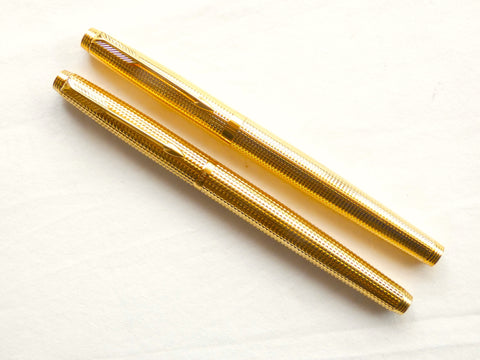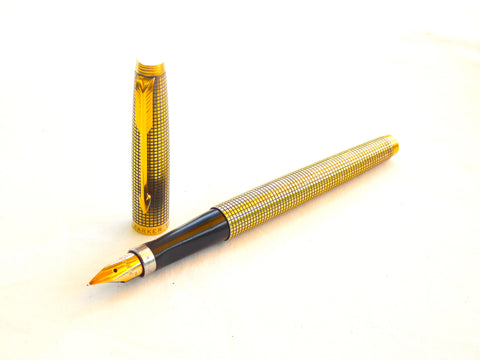Parker 75 Review. A fabulous pen.
The Parker 75 fountain pen is a remarkable pen. In 1964 it was offered at $25, a staggering price tag for a pen produced for the 'mass market'. On paper it looked doomed, it was nothing like the Parker 51 or Parker Duofold, the most successful Parker pens so far, it was a cartridge/converter filler made from solid Silver, the ballpoint pen was ravaging the fountain pen industry, and the 75 was outrageously expensive.

Someone at Parker must have said 'Who needs a Silver pen when a good ballpoint is about a tenth of the price?' The answer was to become clear, about ten million people!
The first Parker 75 was a 'Silver Crosshatch' fountain pen constructed in Sterling Silver, designated 975 signifying 97.5% silver and 2.5% Copper. The pen had a Gold filled trim, the U.K. advertising claimed a 9Ct. Gold clip but no such claim was made in the U.S.A.
Shortly after the introduction of the Silver pen, which became known as the 'Parker 75 Cisele' a Gold filled model known as the 'Parker 75 Insignia' was introduced. The squares on the original Insignia were less pronounced but the later version, shown here, reverted to the deep cut pattern. This is an unused American made Parker 75 Insignia II set from 1979:

The Parker 75 Diamante appears even deeper cut. Each square is topped with a pyramid, giving a diamond effect. the Diamante is the lower pen:

The 'Millerais' finish consisted of closely spaced longitudinal lines, the name actually means 'a thousand lines'. Sad to say, I have counted them and only found 67. Nevertheless, it's another attractive Parker 75 option, and there's also a Silver plated version:


In 1966 Parker offered another variation on the Cisele pattern, the opulent Parker 75 Vermeil. The advert, curtesy of Parker 75.com, is fascinating in that ti virtually predicts the pen's status as a highly collectable item.

This was a top end, luxury version that retailed at double the price of a Silver Cisele. It was originally Gold filled, later Gold plated over Sterling silver. The pen has a unique appearence in that the Silver adds a lustre to the pen which ages to produce a stunning patina:

It is a testament to the very strong design and quality build of the Parker 75 that it continued to be made, with only minor changes, for thirty years and that the model has become even more popular since it was replaced by the Parker Sonnet, a good pen but quite boring when compared to its predecessor.
In 1974 the Flighter was added to thee 75 range. Made in brushed stainless steel, this is just about as robust unbreakable as a fountain pen gets, making it an ideal daily vintage writer. The top of the range Flighter, the Parker 75 Flighter De Luxe, is a particularly attractive version:

In 1979 Parker began producing the 'Laque Collection' of 75s in Meru, France and in 1983 the French subsidiary added the 'Palace Vendome' collection, consisting of Gold and Silver plated pens in addition to the Sterling Silver pens.
The 'Lapiz Lazuli' 75 from the laque collection is particularly striking:

The 'Malachite green striped' pen is also a favourite with collectors.

The Laque 'Red Jasper Quartz' is a particularly bright and attractive pen, it is shown below alongside the 'Thuya' version.

The Parker 75 Custom Laque, made in Red, Blue, Black and Green was a particularly georgeous pen. It featured a cabuchon stone, in the same colour as the pen, set into the cap stud, here is a blue set:

And an identical set, this time in red:

Around 1988 Parker made two changes to the 75 design:
The flat disc in the cap screw was replaced with a dimpled version:

The section was changed from a sculpted three sided contour to a cylindrical shape with the grip part reduced to a smaller 'teardrop' shape:

This was not simply a change of look, or a money saving exercise, but a significant improvement in the ink delivery system. To accommodate a Parker 51 style ink collector, or 'governor', as Parker called it, the section needed to be cylindrical. This meant that the triangular section had to be replaced with a tubular shape, the grip 'teardrop' was added to continue to facilitate the advantages of a rotating nib.

Here's a 1988 Place Vendome 75 in Perle, it has the redesigned section:

'Perle' roughly translates as 'beaded', it is similar to the Milleraies in that it has finely engraved lines but has the added attraction of indentations which give the impression of beads.
The the pen chosen for this review is a 22ct. Gold plated 'Grain d' Orge' (grain of barley) version dating from 1988. It is a fabulous pen:

The length of the pen, when capped as above, is 13cm. The cap is a push fit, it snaps into place with a satisfying 'click' and posts securely in position for writing, although many users prefer not to post a metal bodied pen. The posted length is 14cm:

At each end of the pen is a Gold filled 'stack of coins' stud, this was replaced by a plain stud in the very late models. This pen is quite unusual in that it has a blank cartouche on the side of the cap for engraving a name if required. Around the plain cap band are the words:

A minor change was made in 1988, the cap band was made slightly wider during the year. The photo shows a later 1988 pen with the wider cap band compared to the earlier 1988 pen, both pens carry the same date code.

One of the most innovative features of the parker 75 is the adjustable nib, it is also the most underused. The section is moulded in such a way as to have three 'facets' at 120 degrees to each other. Two of the have milled lines to give grip for the index finger and thumb and the third smooth one sits comfortably against the inside of the first finger. A little experimentation shows that, if the pen is to bear correctly on the paper when the section is gripped in this manner then the nib must be able to be rotated. If it didn't then the contoured section would merely be a hindrance. Many manufacturers copied the contoured section but rendered it useless by having a fixed nib. If you are not convinced then try holding the pen in the left hand then transferring it to the right hand.


Earlier pens had gradations scored on to the collar of the section to enable a favoured nib angle to be reset if it was changed for some reason and the very early pens had a zero position engraved as a reference.

The nib itself is a very handsome affair. Most are 14Ct. gold but some of the French pens have 18Ct. Gold nibs. Parker offered a huge selection of nib types and point widths ranging from 'needle point' to 'double broad' in a range of styles. This particular pen has a 14Ct. Gold 'Normal' Medium nib. It writes extremely well, perhaps a little on the fine side of medium. For a full list of the Parker 75 nib sizes and much more detailed information about the Parker 75 visit Parker 75.com. This is the definitive Parker 75 site, created by a true 75 expert who has kindly allowed me to use some of his images of the more rare Parker 75s in this article.
The Parker 75 is a cartridge/converter filler, a most convenient arrangement as it allows for the ease of use of cartridges with the flexibility offered by the use of bottled ink. The pen performs equally well with both filling systems and which one to use is merely a matter of personal choice. I favour using bottled ink, partly because I always have a range of inks to hand but I do enjoy the process of filling the pen and being able to easily flush it between changes in inks. The use of bottled ink is probably a good deal more environmentally sound and is certainly much, much cheaper than using cartridge
The pen is very comfortable in the hand and is a super writer. It is also a very tactile item with an unmistakable top quality 'feel'. The Parker 51 is often referred to as 'the best pen Parker ever made' but I think this is a questionable assertion when it is compared to the fabulous Parker 75.
Finally here are a couple of rare Parker 75s, images courtesy of Parker 75.com and another view of my all time favourite, the Vermeil.

This pen is a limited edition Parker 75 made from material salvaged from the RMS Queen Elizabeth which sunk in Hong Kong harbour in 1972.. They are not super rare and currently (2020) change hands for around £600.
If you're in need of a super rare Parker 75 then this 'Moon Dust' pen is the one for you. Constructed in Titanium, including the nib, the pen carries a panel containing dust taken from the Moon and sintered with Gold dust. They were never made available to the general public but if you are on good terms with an astronaut he may put you in touch with someone who owns one.

But you will need deep pockets, this pen and the equally rare 'Atlas Booster' Parker 75 sold for $20000 at auction twenty years ago. The price now would be astronomical!
I end with the Vermeil:

